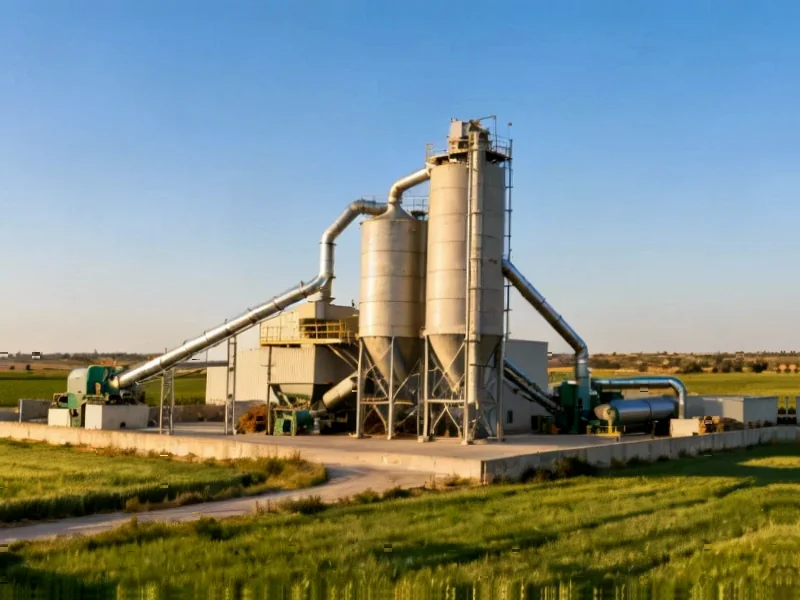According to Manufacturing.net, the Tallgrass Trailblazer Pipeline began operating in September, successfully transporting carbon dioxide emissions from 11 ethanol plants in Nebraska and one in Iowa to be buried 9,000 feet underground in Wyoming. The project stands in stark contrast to other carbon capture pipelines that have faced intense opposition, lawsuits, and legislative blocks, with one competitor accumulating $1 billion in spending without guaranteed success. Tallgrass achieved this through community negotiations and financial support, including creating a community investment fund with an initial $500,000 contribution plus annual payments of 10 cents per metric ton of CO2 transported, expected to distribute over $7 million through 2035 across 31 counties in four states. The company converted an existing natural gas pipeline rather than building new infrastructure, while competitors like Summit Carbon Solutions continue facing landowner resistance and regulatory hurdles despite proposing multibillion-dollar, five-state networks. This successful approach offers important lessons for future energy infrastructure development.
The Stakeholder Engagement Breakthrough
What makes the Tallgrass case particularly instructive is how it addresses the fundamental challenge facing modern energy infrastructure: the gap between national climate priorities and local community concerns. While federal tax credits and market incentives for carbon capture create strong economic drivers for developers, these projects inevitably impact specific communities who may see little direct benefit. Tallgrass recognized that traditional approaches to pipeline development—relying on regulatory approvals and eminent domain—often create adversarial relationships that delay projects and increase costs. Their community investment fund, managed by the Nebraska Community Foundation, represents a sophisticated approach to benefit sharing that directly addresses local priorities like early childhood development, senior care, and food pantries. This isn’t charity—it’s strategic stakeholder management that creates local champions rather than opponents.
Ethanol Industry’s Existential Transformation
The success of this pipeline represents more than just infrastructure development—it’s about the ethanol industry’s survival strategy in an electrifying transportation sector. As sustainable aviation fuel emerges as a potential 50-billion-gallon annual market, ethanol producers face a critical window to reposition themselves. The carbon intensity score improvements enabled by carbon capture directly translate to premium pricing and market access that could determine which ethanol plants survive the coming transition. For agricultural communities across the Midwest, this isn’t just about pipeline routes—it’s about preserving rural economic foundations as gasoline demand potentially declines. The Tallgrass project demonstrates how carbon capture infrastructure can serve as a bridge between traditional agricultural economies and emerging low-carbon markets.
The Replicability Challenge
While Tallgrass offers valuable lessons, its specific success factors may prove difficult to duplicate at scale. The conversion of existing natural gas infrastructure provided a significant advantage that most future projects won’t enjoy, as growing domestic and international natural gas demand makes pipeline availability increasingly scarce. More importantly, the community benefit model requires upfront investment and long-term commitments that may challenge project economics, particularly for larger networks spanning multiple jurisdictions with varying community priorities. The fact that only one other company—Summit Carbon Solutions—continues pursuing Midwest carbon capture pipelines despite federal incentives suggests that the Tallgrass approach, while effective, may not fully solve the broader industry’s challenges.
Regulatory Landscape Complexity
The divergent outcomes between Tallgrass and its competitors highlight how carbon capture infrastructure exists at the intersection of conflicting regulatory frameworks. While the EPA oversees rigorous underground injection protocols for carbon storage, pipeline routing authority remains largely with state and local governments, creating a patchwork of requirements that can stall multi-state projects. South Dakota’s legislative ban on eminent domain for carbon pipelines demonstrates how local opposition can reshape project economics and routing strategies, forcing companies like Summit to redesign entire network configurations. This regulatory fragmentation means that carbon capture success requires not just technical and financial competence, but sophisticated political navigation across multiple jurisdictions with varying priorities and power structures.
Future Infrastructure Implications
The Tallgrass experience suggests that the era of top-down energy infrastructure development may be ending. As communities become more organized and assertive about their interests, successful projects will need to incorporate stakeholder engagement as a core competency rather than a regulatory compliance exercise. This shift requires energy companies to develop new capabilities in community negotiation, benefit structuring, and long-term relationship management. The approach also raises important questions about equity—will community benefit agreements become standard practice, potentially increasing costs that get passed through to consumers? Or will they remain exceptional arrangements for particularly challenging routes, creating inconsistent outcomes across different communities? The answers will shape not just carbon capture development, but the broader transition to low-carbon energy systems.
Market Transformation Potential
Beyond the immediate project success, the Tallgrass pipeline demonstrates how carbon capture infrastructure can enable market transformation across multiple sectors. By creating a pathway for ethanol to qualify as sustainable aviation fuel, the project helps bridge the gap between established agricultural industries and emerging clean energy markets. This connectivity could prove crucial for decarbonizing hard-to-electrify sectors like aviation while preserving rural economic foundations. However, the limited scale of current carbon capture pipeline development suggests that realizing this potential will require more systematic approaches to stakeholder engagement, regulatory coordination, and benefit sharing than the industry has demonstrated to date.




